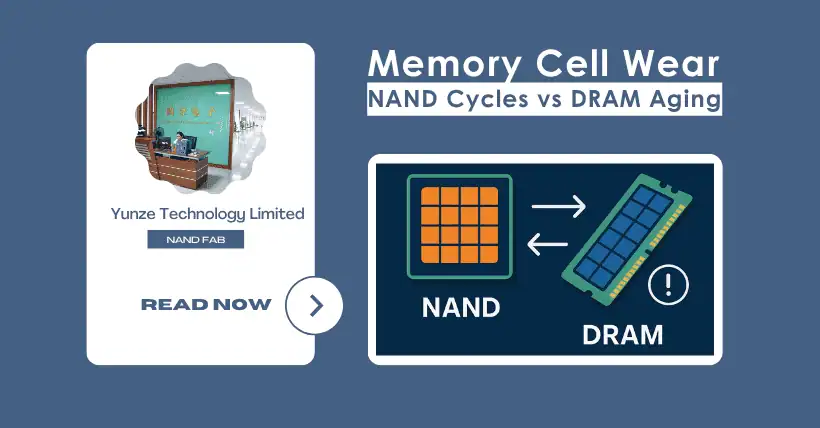This is a NAND flash memory cell, which is the unit used to store data. The storage unit of NAND flash is a floating-gate transistor, and data storage is achieved through electron injection and release. The core factor of its “lifespan” is the number of Program/Erase (P/E) cycles.
When writing data, a voltage higher than that of the substrate is applied to the Control Gate, causing electrons from the substrate to pass through the Isolation Oxide Layer into the Floating Gate. During erasure, the process is reversed: voltage is applied to the substrate, and electrons in the Floating Gate pass back through the oxide layer into the substrate. Therefore, it is the Floating Gate that truly stores data or charge.
Physical wear: each erase/write operation causes slight damage to the floating gate’s oxide layer. Over time, this accumulation can lead to electron leakage, eventually causing the memory cell to fail.
This is a DRAM memory cell. The storage unit of DRAM consists of a capacitor and a transistor. Its working mechanism makes it fundamentally different from NAND flash. During data writing, if the data is 1, the capacitor is charged; if the data is 0, the capacitor remains uncharged. Thus, the capacitor is the medium that stores the data. Due to leakage, the capacitor cannot hold data for long, so it needs periodic refreshing (typically every 64ms). The refresh process involves reading and rewriting the data, not physical erase-write operations like in NAND, so there is no wear from program/erase cycles.
The biggest problem with NAND is the constant shuttling of electrons between the Floating Gate and the Substrate. The Isolation Oxide Layer between them gradually wears out, and eventually the Floating Gate can no longer reliably store charge.
Aside from MOSFET aging, DRAM has virtually no parts that wear out. And because the capacitor leaks quickly and cannot retain data for long, DRAM must be refreshed at a high frequency to recharge the capacitor and retain data. This happens every few dozen milliseconds, whether or not the memory data is being changed.
DRAM’s “lifespan” is more akin to the aging cycle of standard electronic components. Common failure causes include:
Increased capacitor leakage: after long-term use, capacitor performance degrades, leading to failed data refresh.
Transistor degradation: threshold voltage drift can cause logic errors.
Temperature and voltage effects: high temperatures or overclocking can accelerate hardware aging, but this is gradual wear, unlike NAND’s exhaustion of program/erase cycles.
Due to their different physical structures, DRAM memory stores data by charging a capacitor—charged is 1, uncharged is 0—but since it can’t hold charge for long, it must be constantly refreshed (recharged). If not refreshed, or if the device is powered off, the capacitor discharges and data is lost. As long as the capacitor can still hold charge, it can still be used. It’s difficult for a capacitor to degrade to the point of being completely unable to hold charge. In NAND (SSD), data is stored through semiconductor electron migration. With enough cycles, the semiconductor’s ability degrades—after heavy electron migration, atoms may shift as well, and the polarity can no longer be distinguished.
Related:

Disclaimer:
- This channel does not make any representations or warranties regarding the availability, accuracy, timeliness, effectiveness, or completeness of any information posted. It hereby disclaims any liability or consequences arising from the use of the information.
- This channel is non-commercial and non-profit. The re-posted content does not signify endorsement of its views or responsibility for its authenticity. It does not intend to constitute any other guidance. This channel is not liable for any inaccuracies or errors in the re-posted or published information, directly or indirectly.
- Some data, materials, text, images, etc., used in this channel are sourced from the internet, and all reposts are duly credited to their sources. If you discover any work that infringes on your intellectual property rights or personal legal interests, please contact us, and we will promptly modify or remove it.



